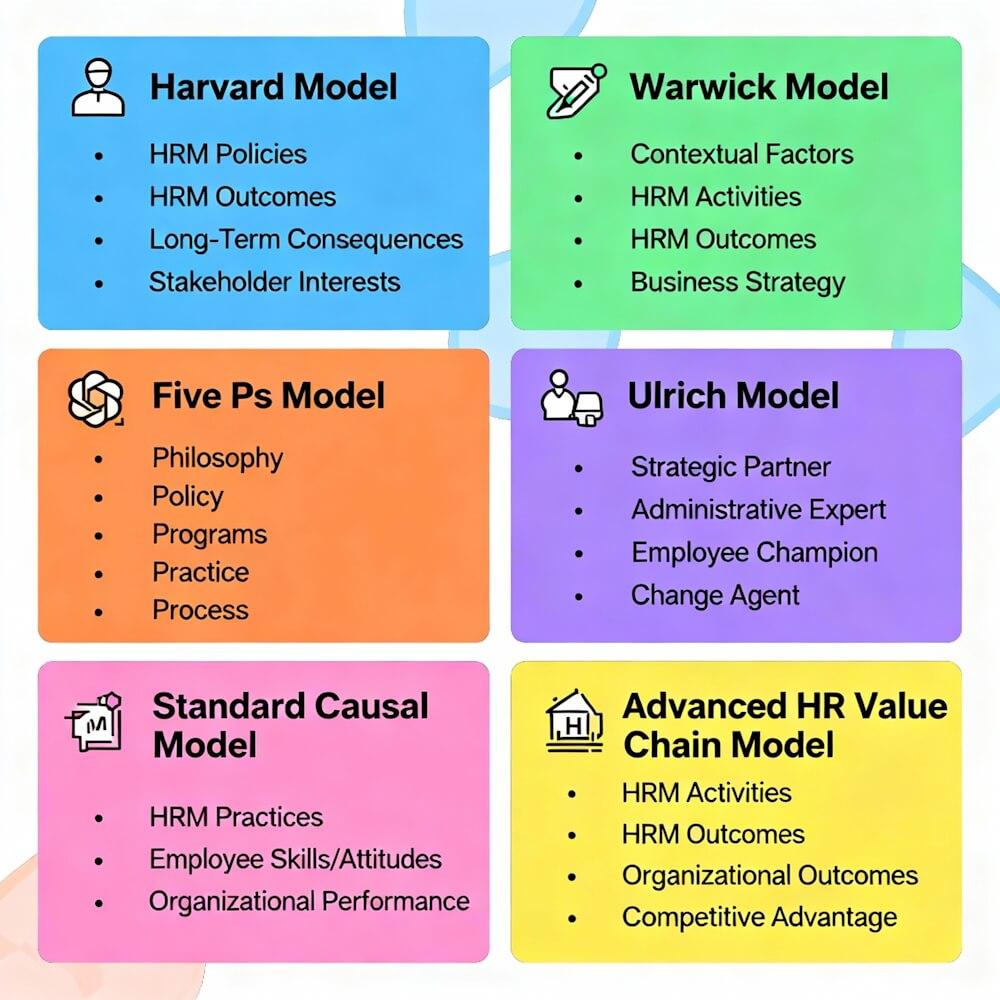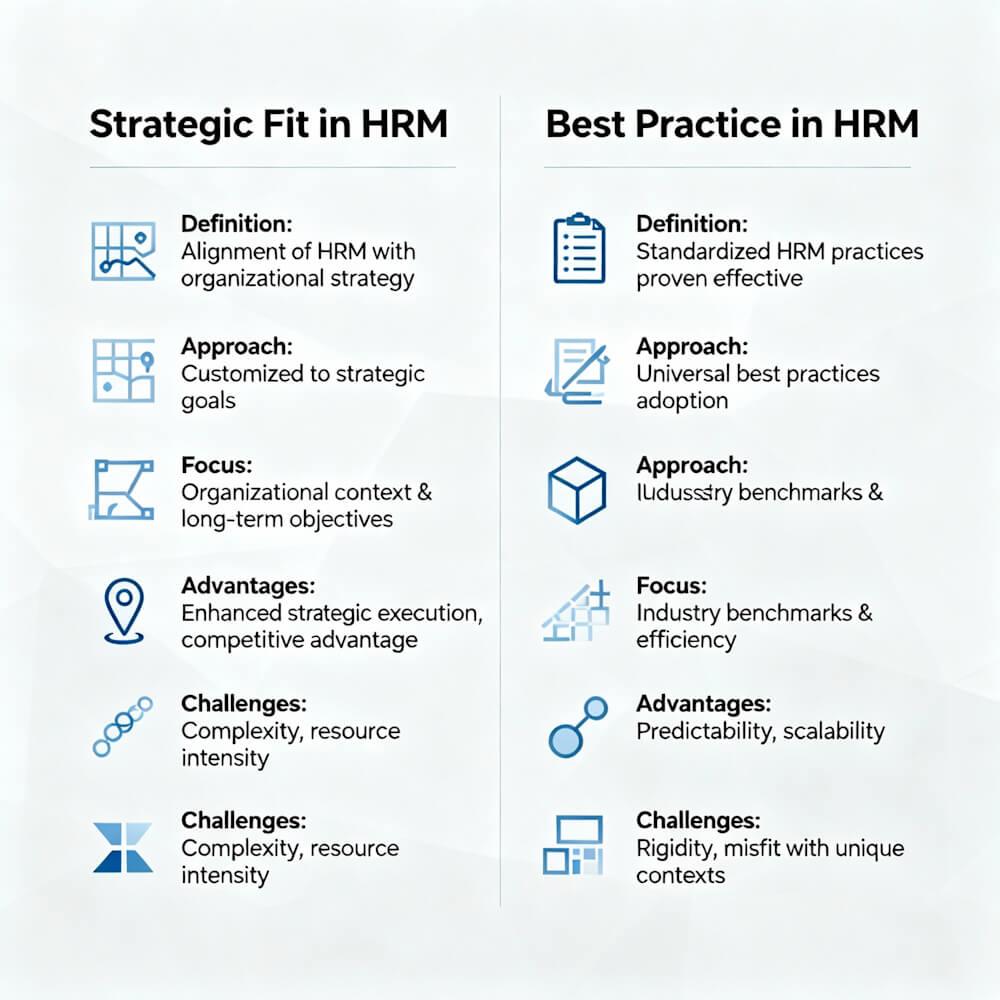The Harvard Model
The Harvard model of human resources is one of the most well-known and widely used. It was created by Michael Beer in 1984 and modified over time, with contributions by other specialists such as Paauwe and Richardson in 1997. It is currently one of the most complex, versatile, and holistic HR techniques in use.
Five Segments of the Harvard Model
1. Interests of Stakeholders
Stakeholders are any group with a vested interest in the company's success. Shareholders and management are traditional stakeholders, but modern stakeholders might include employee organizations, unions, and even governmental interests. HR policies are developed based on the combined impact of stakeholders.
2. Situational Factors
Situational factors are a set of circumstances that affect a person's life. HR is influenced by situational factors such as the workforce, environment, industry, or society. Stakeholders' positions and influence are affected by these forces. Self-interest, social values, law, or an aggressive worker union, for example, may affect a company's c-suite.
3. Human Resource Management Policies
These are the policies, workflows, and processes that have been adopted within the company. Hiring, training, incentive and feedback systems, and other tasks are included. The creation of HRM policy is influenced by stakeholder interests and situational circumstances.
4. HRM Outcomes
HRM outcomes are the outcomes of the policies created by the aforementioned influences. Employee retention, dedication, competency, and cost-effectiveness are examples of business outcomes. They are the tangible, trackable key performance indicators for HR.
5. Long Run Consequences
The Harvard model comes to a close with this part. It is a comprehensive examination of a company and its people. It assesses the company's standing in its market and in society as a whole, as well as the overall well-being of its employees.
The long-term consequences of HRM feedback into the three main pillars of the model are the key to this model. Stakeholder interests, situational conditions, and specific HRM policies are all adjusted based on long-term repercussions (and the data collected about them).
Long-term consequences provide feedback that helps enhance the initial effects, which can then flow through the system and produce new, ideally better, long-term outcomes.
The Warwick Model
Chris Hendry and Andrew Pettigrew, both of the University of Warwick, established the Warwick Model of Human Resources in the 1990s. The standard Harvard model was employed as a starting point, but it was improved further.
Like the Harvard model, it focuses on five elements of HR.
1. Outer Context
Political, legal, technological, economical, and competitive impacts are all macro-environmental elements that influence a company's HR policy.
2. Inner Context
These are the internal company factors that can have an impact on HR policies. Structure, leadership, culture, technology, and business outputs that trickle back into the organization are all examples.
3. Business Strategy
These are the company's basic HR strategy in action. It may comprise corporate objectives, overarching company strategy, and product market effects.
4. HRM Context
The ground-level policies, roles, and organization of human resources within the organization, as well as the HR outputs, are the focus of context.
5. HRM Content
This section discusses the policies, procedures, and systems that are used in HR. They include, among other things, reward systems, employee interactions, work processes, and HR feedback.
In general, this approach tries to balance inner and outward context influences, particularly when they are at odds with one another. The two contexts feed the overarching approach, which in turn feeds the context and content. HR implementation then feeds back into both inner and exterior environments, influencing both directly and indirectly through societal forces.
The lack of a defined feedback loop between internal HR practices and external company outcomes is the model's fundamental flaw. Instead, feedback loops must filter through multiple contexts, causing them to become muddled and making it more difficult to discern which inputs cause which affects.
The Five Ps Model
Randall Schuler, a known and recognized specialist in HR and currently a distinguished professor emeritus at Rutgers University, established the Five Ps model, or 5Ps, in the early 1990s.
The model identified five P categories that influence human resource behavior in general.
1. Philosophy
In the corporate world, this is the organization's mission, overarching vision, and goals.
2. Policies
These are operational protocols that are chosen and implemented to achieve certain goals within a company's objectives.
3. Programs
These are the specific business and HR processes, as well as organizational procedures and architecture, that are used in day-to-day operations.
4. Practices
These are the people who work in the company, from the CEO to the newest hires, and how they relate to the three Ps outlined earlier.
5. Processes
This is the overall status of results, which are often recognized as key performance indicators and assessed, and whose observation feeds back into defining and changing the other four Ps.
All five Ps must be in balance in order for this paradigm to work. They all flow into one another, and the outcomes of their interactions must be balanced in order to meet the overall business objectives intended by company leadership, company employees, and society at large.
The Ulrich Model
The Ulrich Model, developed by Dave Ulrich in 1995 and subsequently developed by him in 1997, focuses on categorizing every influencer of a company's HR strategy into one of four positions.
Four Key Roles in the Ulrich Model
- Strategic Partner
- Agent of Change
- Administrative Expert
- Employee Champion
In addition, the CEO and top management play a role. With this paradigm, HR's general processes take a second seat to the organization's people and the roles they perform. The business partner model is another name for this strategy.
In recent years, there has been discussion on whether or not this approach is still sustainable today. Instead of a few distinct "champions" and organization influencers, modern sensibilities prefer that everyone inside an organization has a voice. Nonetheless, the model can be a useful method to look about HR from the perspective of the people involved rather than the processes and algorithms in use.
The Standard Causal Model
This model is a condensed version of a number of comparable models created in the late 1990s and early 2000s.
It has a structure that is nearly equivalent to the Harvard model and records the feedback between HR results and strategies.
Structure of the Standard Causal Model
- At the top of the pyramid is the general corporate plan. This strategy directs the company's overall aims and objectives.
- The overall business strategy drives the HR strategy, which in turn influences everything below it in the chain.
- HR practices are the processes, structures, and operational goals that guide a company's day-to-day operations.
- HR outcomes are exactly that under the Harvard model; they are the specific outputs of the whole HR process.
- Internal performance refers to the assessment, monitoring, and adjustment of how the company performs with its current HR procedures.
- The end outcome of all the processes that have gone before it is financial performance.
After all, if a company doesn't focus on the entire financial results of its activities, it won't last long. The findings are incorporated into procedures and outcomes in order to improve them and, as a result, improve finances.
As you can see, this is a pretty generalized model, and many different models build on it. Many HR professionals utilize this as the foundation for their custom-made models for each organization they work with.
The Advanced HR Value Chain Model
This is another generalized model that uses the value chain concept and adjusts it over decades with contributions from various HR influencers.
As a result, it can no longer be linked to a single individual or organization. It is made up of a value chain.
Components of the Advanced HR Value Chain Model
1. HR Enablers
HR Enablers are the influential components of a business that make a good HR process possible, such as the HR mechanism's processes, design, marketing, and money.
2. HR Activities
HR activities are the duties and activities that are engaged in human resource management. Workforce planning, recruitment, development, and remuneration are among them.
3. HR Outcomes
HR Outcomes are the industry standard for measuring employee retention, engagement, performance, cost, and talent management.
4. Strategic Focus
Strategic Focus is an external assessment of overall HR strategy that informs both HR results and KPI tracking.
5. Financial KPIs
Financial KPIs, customer-focused KPIs, and process KPIs are the three types of KPIs that are tracked. HR Outcomes support this monitoring process by feeding data into the outcomes.
Overall, this model is nuanced and product-focused enough that it is widely employed in enterprises in some form or another.


